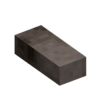Iron/de: Difference between revisions
(Replaced content with ".") |
No edit summary Tag: Reverted |
||
| Line 39: | Line 39: | ||
== Usage == | == Usage == | ||
[[Special:MyLanguage/Anvil|Amboss]] | |||
=== [[Smithing]] === | === [[Smithing]] === | ||
Revision as of 12:23, 16 January 2023
| Iron | |

| |
| Stackable | 16 |
| Smeltable | |
| Smelt Point | 1482°C |
| Requires Container | Yes |
| Gegenstände | |
.
Obtaining
.
Ores
There are three types of iron-containing ores in the game: hematite, magnetite and limonite. They can appear in different rock layers at different depths, but all are equally capable of producing iron. 20 nuggets of these ores produces one iron bloom. A tier 3 bronze (or better) pickaxe is needed to mine these ores.
Hematite can be found in large, deep underground deposits in limestone, granite, peridotite, and phyllite. Magnetite can be found in andesite, chalk, conglomerate, claystone, and slate. Limonite can be found in chert, shale, and basalt. Taken as a whole, this means iron ores can generate in any rock layer except for sandstone and bauxite.
Bloomery
See also Bloomery.
In order to turn iron ore nuggets into iron blooms, the ore nuggets must be smelted in a bloomery, created from fire clay bricks. The bloomery must be loaded with the ore, then with an appropriate fuel - either charcoal, black coal or anthracite coal. The bloomery will burn for around 10 hours, after which it may be broken open to retrieve the iron blooms. Bloomeries are destroyed after a single use, so a new one must be made each time the player wants to turn iron ore nuggets into iron blooms.
Wrought iron
Iron blooms must be further worked on an anvil while hot to turn it into usable wrought iron ingots. This may be done manually, with a hammer and a bronze or better anvil, or be automated with a helve hammer. Cold iron blooms can be reheated in a forge.
Manual processing is done by placing a hot iron bloom on the anvil. Using a hammer, remove all the dark slag spots and manipulate the hot iron into the shape of an ingot. With a helve hammer setup, the bloom just needs to be placed on the anvil under the hammer, and it will slowly be turned into wrought iron. Each hit of the helve hammer removes a single voxel, so processing speed is dependent on the specific setup of the machine.
Usage
Smithing
Iron can be used to create a wide variety of tools, weapons, armor, and other useful items.
Alloys
See also steel.
The only alloy of iron currently in the game is steel, which is an alloy of iron and carbon. Steel is the highest tier metal in the game, but requires a complex process to create.
Progression
Acquiring iron tools and the means to produce iron is referred to as entering the "Iron Age". Iron has several advantages over bronze in item durability and efficiency, but also the availability of iron ore as compared to the metals needed to create bronze. On the other hand, iron is harder to work with as it cannot be cast, only smithed. Additionally, iron ingots require a more complicated process to make, and requires players to find a good source of fire clay as well as produce large quantities of high-temperature fuel.
| Erze, Metalle und Mineralien | |
|---|---|
| Guides | Erzansammlungen • Metalle |
| Nützliche Metalle | Kupfer • Eisen • Meteor Eisen • Gold • Silber • Blei • Zinn • Zink • Bismuth • Titanium (Ilmenite) • Nickel |
| Nützliche Legierungen | Bronze (Zinnbronze, Bismuthbronze, Schwarzbronze) • Stahl • Messing • Lötkolben (Lötkolben aus Blei, Lötkolben aus Silber) • Molybdochalkos • Cupronickel • Electrum |
| Mineralien | Alaun • Borax • Zinnober • Kohle • Halit (Salz) • Lapislazuli • Quarz • Salpeter • Schwefel • Pottasche |
| Werkzeuge | Spitzhacke • Hammer • Geologenhammer • Crucible • Schmiede • Ore blasting bomb • Handmühle • Amboss • Hochofen • Stielhammer • Pulverisierer |
| Sonstiges | Edelsteine |
| Related mechanics | Schürfen • Erzabbau • Clay forming • Metallgießen • Schmieden • Stahl Herstellung |